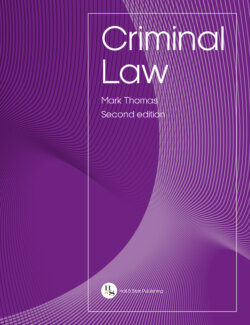Читать книгу Criminal Law - Mark Thomas - Страница 44
На сайте Литреса книга снята с продажи.
1.7.2.3Burden and standard of proof Burden of proof
ОглавлениеIn criminal cases, the fundamental principle is that the prosecution bears the burden of proving that the defendant committed the offence in question. This fundamental principle is known as the ‘golden rule’ and was emphasised by the House of Lords in Woolmington v DPP [1935] AC 462, where Viscount Sankey famously stated:
Throughout the web of English criminal law one golden thread is always to be seen, that it is the duty of the prosecution to prove the prisoner’s guilt.
This principle is reinforced by Article 6(2) of the ECHR which prescribes that an individual is to be considered innocent until proven guilty. There are, however, exceptions to the principle that the prosecution bears the burden of proof. Before we consider these, however, it is first necessary to explain what burdens of proof exist. Two burdens of proof exist, namely:
• the legal (persuasive) burden; and
• the evidential burden.
The legal burden, also known as the ‘persuasive’ burden, is the obligation placed on a party to prove a fact in issue (see 1.7.2.1). In the majority of cases, the prosecution bears the burden of proving the legal burden, ie it has the burden of proving all of the facts necessary to establish the defendant’s guilt. This is so even if this involves proving negative elements; for example, in a case of rape, the prosecution bears the burden of proving that sexual activity took place (a positive element) and that the complainant did not consent (a negative element) (R v Horn (1912) 7 Cr App R 200). Whether the legal burden is discharged is a matter of fact for the arbiters of fact.
The legal burden can be compared with the evidential burden, which is merely an obligation on a party to adduce sufficient evidence to raise a fact in issue, ie to make an issue live. Such examples may be the need to raise sufficient evidence of the existence of a defence, such as self-defence. Whether the evidential burden is discharged is a matter of law for the judge. Where the evidential burden has been discharged, the judge can place the evidence before the arbiters of fact who can use it in determining whether the legal burden has been discharged.
As explained above, the golden rule (or ‘thread’ as it is also known) is that in all criminal proceedings, the prosecution bears the legal burden of proof. This is, however, subject to a number of exceptions which Doak, McGourlay and Thomas, Evidence: Law and Context, 5th edn (Routledge, 2018) argue have ‘tarnished’ the golden thread. These exceptions are more likely to concern the requirement to prove the existence of a defence, as opposed to disproving an element of an offence. The ways in which such exceptions come about are detailed briefly in Table 1.6.
Table 1.6Tarnishing the golden thread
| Exceptions to the golden rule | Explanation |
| Common law | The only common law rule which reverses the burden of proof involves the defence of insanity, where the defendant bears the burden of proving that the defence exists (M’Naghten’s Case (1843) 10 Cl & Fin 200). |
| Statute (express) | In many cases, legislation will stipulate quite clearly that there is a reverse burden and the defence must prove certain circumstances to be in existence in order to make use of an available defence. For example, s 2(2) of the Homicide Act 1957 provides that the defendant must prove the defence of diminished responsibility. |
| Statute (implied) | In other cases, the legislation will not prescribe that a reverse burden exists, but, as a result of s 101 of the Magistrates’ Courts Act 1980, where the defendant intends to rely on any ‘exception, exemption, proviso, excuse or qualification’ in the statute, it is his obligation to prove such exception. This rule only applies to cases tried in the magistrates’ court but the common law has extended the principle to cases tried in the Crown Court also (R v Edwards [1975] QB 27). |
These reverse burdens are controversial given the potential effect they may have on a defendant’s right to a fair trial. It is contended that such reverse burdens do not affect a defendant’s right to a fair trial as they affect only the requirement to prove the existence of a defence and not to disprove an element of the offence. The presumption of innocence remains intact by requiring the prosecution to prove that an offence took place; it is only fair that the defence bears a limited burden of proving the existence of a defence. In circumstances where the reverse burden appears to require the defendant to disprove an element of the offence, the courts have been quick to ‘read down’ the provision under s 3(1) of the HRA 1998, such that it merely imposes an evidential burden. This was evident in the case of R v Lambert [2001] UKHL 37 concerning a charge of possession of drugs.
In AG’s Reference (No 4 of 2002) [2005] 1 AC 264, the House of Lords held that in order for a reverse burden of proof to be legitimate, there must be compelling reasons justifying why it is fair and reasonable to deny the accused person the protected right under the ECHR. See Dennis, ‘Reverse Onuses and the Presumption of Innocence’ [2005] Crim LR 901 for a discussion of the lawfulness of such reverse burdens.
